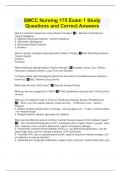Exam (elaborations)
SMCC Nursing 175 Exam 1 Study Questions and Correct Answers
- Course
- Institution
Name 5 common reasons for using Infusion therapy? 1. Maintain fluid balance / correct imbalance 2. Maintain Electrolyte balance / correct imbalance 3. Administer Medications 4. Administer Blood Products 5. Nutrition Name 4 priority concepts associated with Infusion Therapy Fluid Electrolyte balanc...
[Show more]



